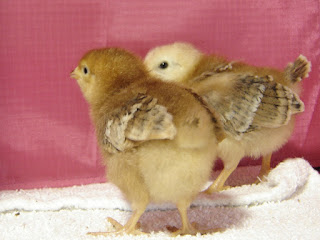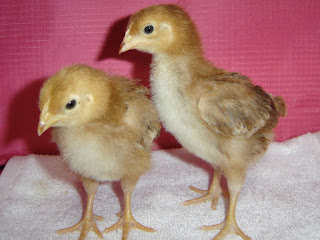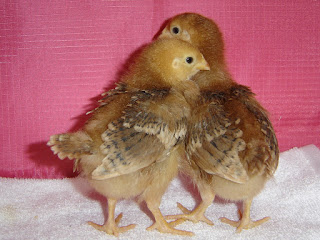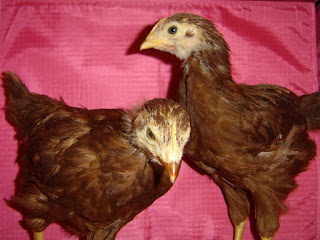The past couple of years, we have taken on a new adventure during the Covid Pandemic. We started raising new hatchlings into young pullets that are ready to go outside. So we have had the opportunity to take weekly photos of them as they are growing. For example, the Rhode Island Reds are a popular breed that we start for others.
Week 1
Week 2
They are growing quickly. They have almost doubled in size even though they do not look like they have. They are much less prone to pasty butt after two weeks, but it can still happen, into their third week. They are still very squatty in appearance. Their beaks are growing stronger and may develop color on the tips, depending on the breed. They are growing more wing feathers, and they are starting to get distinct tail feathers. The interesting things about the Rhodes is that the color on their wings now is not what it will be in a few weeks. After two weeks of age, you can stop feeding the eggs with their feed, and start providing small amount of treats, like chopped up apple, mashed canned corn, or finely chopped broccoli, along with sand or very fine grit twice per week. This helps them to become accustomed to these treats when they get older. (Not too much and not daily. It will mess with their development and egg production, if they get too fat.)
Week 3
Now their legs are growing longer and they are starting to stand a bit more upright. From the front, they still look cream to tan in color, but when they turn around, you start to see the reddish color coming in down their backs, and towards their tail feathers. They are not as vulnerable to the temperature, but they are vulnerable as they attempt to fly. They can smack into objects and get hurt because they do not yet have the skills they need to fly safely. They are ready for toys in their brooder. A mirror or two, and a bell. A colorful cat ball to roll around with a bell inside is also fun. A rope swing or a branch perch is also fun to try to fly up to, and fly off of. At this point, make certain to have plenty of floor space for your chicks. At least 1 square foot per chick to keep their stress levels down. Do no count the space that the food, water and other things take up in the square footage total. Not enough space and they may start pecking on each other. That's never fun to deal with.
Week 4
At four weeks, they are better at flying with more sturdy wing and tail feathers developing. A lot less down on their bodies at this point, and they are starting to stand more upright, look a bit gangly, and hve quite the mix of down and feathers. I call this the long neck stage as they can really stretch out their necks now. But when they want to, they can look quite compact and squatty like little chicks. That's the nature of the 4 week old chick. Their heads are still mostly down and cream colored. But if you look closely, you see that feathers are starting to develop up onto their necks and down the sides of their chest to the tops of their legs. The true mahogany red color is filling in on their bodies. Their flying skills are much more adept now, plus their pecking order is well established. The dominant birds will be the first to fly or run towards you, while the less dominant birds will hang back in the flock. They are able to eat small seeds and cracked corn as occasional treats now, as long as you include some grit with it. They also may like to experiment with dried meal worms that are not too large in size. Keep the toys in the brooder to give them distractions and to help the more timid birds to get some reprieve from the dominant ones.
Week 5
The first real resemblance of being mature chickens now. They are taller. Definitely more upright and almost fully feathered. Their feathers are starting to form on their heads, but there is will some down on their chests, on the top of their heads, and a little around the top of their necks. This is really the last area on their body where they are not quite insulated enough to go outside, if your area is below 55F at night. You need to wait until those down feathers are really gone. Once they are fully feathered, they are ready to live outside with a coop for them to sleep inside safely on a roost. At this point, my chicks are already sleeping on a roost in their brooder at night without a heat source in the barn, as long as the temps do not drop below 45F in the barn. I have a small space heater near their brooder set to come on and warm the air around the brooder, if it gets too chilly, especially in the early spring. The chicks, as almost young pullet chickens, will need more floor space again. At this point, they will need at least 1.5 square feet per bird to reduce stress levels and space to do their thing. Yes, I get that sometimes, you will see them all huddled together, sleeping soundly in the corner of the brooder or side by side on the roost, but that is not a constant, buddy-buddy stance. They need their space to exercise and act like chickens, too.
Week 6
The amazing transformation of the chick into a young chicken happens spectacularly fast. Their chests, sides, backs, wings, tails, and the tops of their legs are fully feathered now. Their heads are just about feathered with only a little down peeking through those new feathers. Depending on the weather outside, they might be ready to go live in their coop without any additional heat source. If your nighttime temps are dropping below 45F and your daytime temps are consistently below 55F, then I definitely recommend that you include a heat source, whether it is a brooder warming plate, or a coop heating panel, for a couple of weeks. It is not a good idea to use a red heat lamp unless you have a very large coop where you can hang the lamp safely away from the birds and won't catch anything on fire. Until their heads are fully covered with feathers and they have had a chance to acclimate to the cooler temps, by being outside a week or two, you can then take the heat source away and they should do just fine, unless it starts snowing/freezing outside. That happens sometimes during mid-spring in our area.
Personally, we don't use a heat lamp with our brooder chicks because we know of too many people that have lost their chicks and homes to fires caused by them. We rely on the brooder warmer panels to keep our chicks safer, warm, and healthier. Our chicks are less stressed out because they use the panels to hide under when they get scared, or cold. During the first week, we keep the food and water close to the panel. Week two, the food and water is moved a foot away from the panels. Week three, the food and water is moved totally away from the warmer panels.
Our exception to the rule with Heat Lamps - For our meat chickens, during really cold or rainy periods, we will hang a low wattage red heat lamp inside the coop to encourage the birds to get inside and out of the elements since they seem a tad too dumb to figure out that it is warmer and dryer inside, without that light on. Luckly, our layers/hens are much smarter than that.










